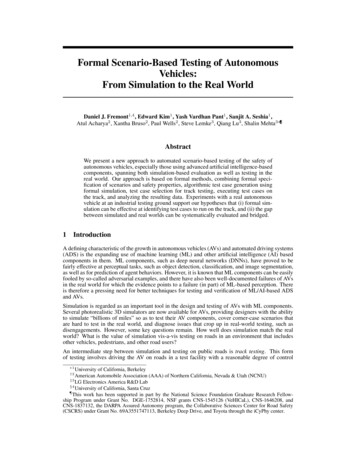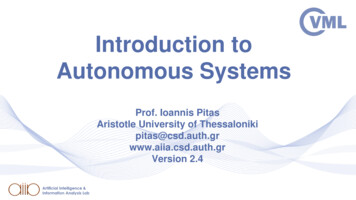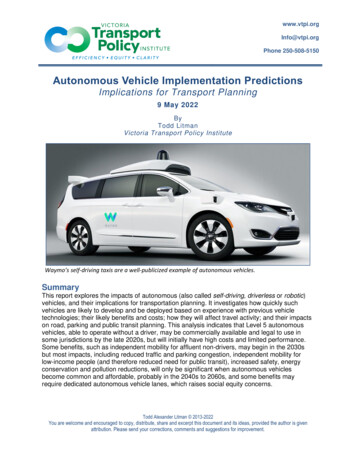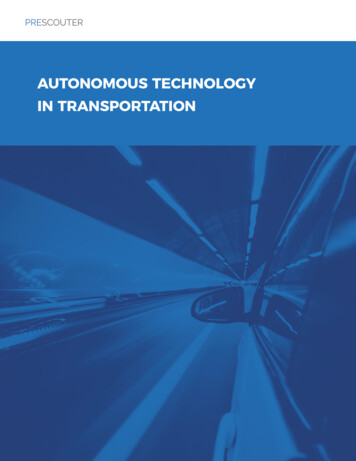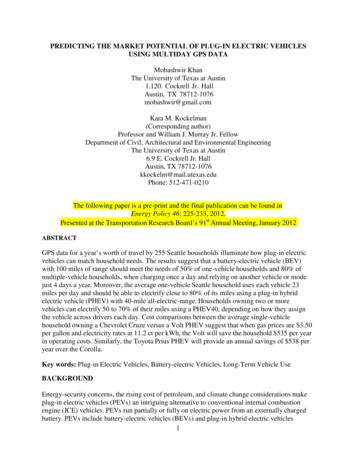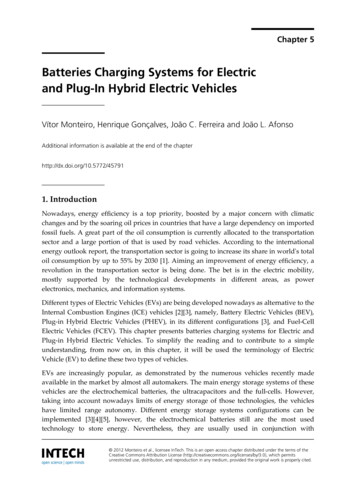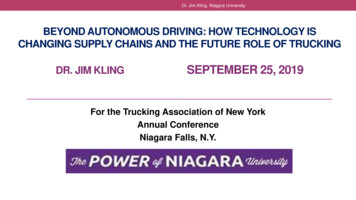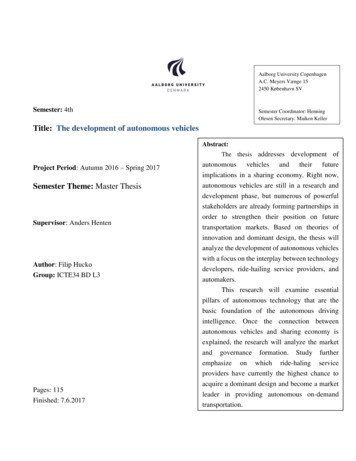
Transcription
AUTONOMOUSVEHICLESWhat are the roadblocks?
2AUTONOMOUS VEHICLES: WHAT ARE THE ROADBLOCKS?IN BRIEFCONTENTSIN BRIEFIN BRIEF3WHO SHOULD READ THIS REPORT4WHAT DO WE NEED TO ENABLE DRIVERLESS CARS?6HOW WE DEFINE PROGRESS8HOW FAR IS THE UK DOWN THE ROAD TO DRIVERLESS CARS?10PA INSIGHTS11PROGRESS AND BARRIERS IN EACH CAPABILITY12THE CAPABILITIES IN DETAIL14Driverless cars, or Connected Autonomous Vehicles(CAVs) are hard to avoid. Almost every week, they’reon our TVs and radios, and in our newspapers. Someare even on our roads, in a growing number of pilotprojects. Established automotive giants are busydeveloping autonomous vehicles. So are newer carbuilders like Tesla. And of course, so are disruptorsfrom outside the industry, like Google and Apple.Already, our cars can do some of our thinking for us.They tell us when we’re too close. They help us parkand stay in lane. They turn on their own lights andwipers. They’re connected to manufacturers. And theytell emergency services when we’ve had an accident.But we’re still in the driving seat, doing the driving.These evolutions are just embellishments of cars aswe’ve always known them.CAVs promise a revolution. They’ll be in control.We’ll be passengers; picked up, dropped off at ourdestinations and picked up again when it’s timeto go home. Technology Regulations And Law ComplianceIn theory, when they’re on our roads, our lives will be: Insurance Safer; we’ll have fewer, less serious accidents Public Acceptance More efficient; we’ll get about faster on lesscongested roads Roads Greener; less congestion means more fuelefficiency, lower emissions and cleaner air PolicyIs it just hype? If it’s not, how long before these carsare actually on our roads? What needs to happen tomake them a reality?Besides the technology, many things will need to cometogether, including:Regulation: who oversees how the vehicles are usedand what new laws will we need?Insurance: who’s liable if something goes wrong?Compliance: how do we enforce laws and regulations?Roads: do we need new ones? How do authoritieswork with other bodies to cater for driverless cars?Users: will people think it’s worth switching todriverless cars?Clearly, while the technology matters, it’s aboutmuch else besides. Nothing is solved until everythingis solved.To find out how close we are to the driverlessrevolution, we’ve created a framework of thecapabilities behind it. It raises important questionsfrom the many different perspectives involved inmaking driverless cars happen. This report shareswhat we’ve found so far by using the frameworkto get experts’ views. And we’ll carry on using itto plot progress towards roads without drivers. Freer; less driving means more time for other thingsCONCLUSION28PA CONTRIBUTORS30Charlie HendersonPartner, Roads & RegionsPA Consulting Group3
4AUTONOMOUS VEHICLES: WHAT ARE THE ROADBLOCKS?WHO SHOULD READ THIS REPORT5WHO SHOULD READ THIS REPORTHighways authoritiesBecause cars have evolved only gradually, theway we manage roads hasn’t had to changesubstantially or quickly. CAVs will change that.Highways authorities face challenges beyondoperational ones like adapting road markingsand traffic lights. The strategic challenges couldtake them by surprise if they don’t collaboratewith manufacturers. If they work independently,it could hold up adoption or undermine safety.And managing a mixture of driverless andconventional cars will need them to join forcesto create the right operational protocols.InsurersLaw enforcementThe law today centres on control ofthe vehicle. Defining that becomes harder whenthe car is the driver. Enforcers need new skillsto analyse software as evidence. They’ll needto discern which vehicles are autonomous andjudge how non-CAVs interact with them.Liability is the big question. Can a driver who isn’tdriving be liable for an accident? As well as that,insurers have to figure out how to: price risk for events that haven’t been tested– with no historical data to draw on, the usualmethod won’t be an option early on investigate claims – insurers will need to identifymechanical faults or software glitches in caseswhere manufacturers are liable insure driverless car manufacturers – they’llneed extra cover because insurers will be ableto claim against them for software problems.Regulators and LegislatorsRegulators and law makers can enable driverlesscars or block them. Attitudes will vary. Somewill be cautious, others liberal. Legislators andregulators could see a chance to create anenvironment that puts their country ahead;encouraging investment and driverless car trials.Already manufacturers and technologydevelopers are moving, stopping and startingtrials based on signals from regulators.Technology developers, are watching for signslike: recognition that driverless cars are differentto existing cars a stable, consistent and forward looking regime scope for innovation in elements that holdcompetitive advantage, but rigid standards forelements that don’t.Communicationsand systems providersDisruptive change to any industry creates effectsthat are hard, and sometimes impossible, topredict. Think about the advent of ‘text speak’brought about by SMS messaging technology,or the growth of vlogging made possible bysmartphone cameras and platforms like YouTube.Consumer trends like these are unpredictable, butsignificantly change ways of working and howfuture products and services develop.Car makers have segmented their productsbased on driving experience and refinement.New mobility, with its new use cases andin-car functionality, means consumers willexpect new choices and outcomes fromtheir mobility providers.For communication systems and connectivityproviders, the challenge will be how to stayrelevant in this new ecosystem. A key step toachieving that will be to segment customersby the outcomes they’re looking for.Government and policy makersCAVs could transform city landscapes and createmany jobs for those with the right technologyskills. But demand for commercial drivers willprobably plummet.So far, car builders and tech entrepreneurs, mostof them overseas, have led on developing mobilitytechnology and services. But UK national andregional governments need a strategy to makesure the UK shapes the implementation ofconnected and autonomous vehicles. This willhelp make the most of the potential benefits andminimise the negatives. Not doing this could seethe UK’s commercial driving jobs becominghi-tech jobs in California.Automotive ManufacturersAll car builders are investing heavily in driverlesscars. They’ll have to decide how the driverlessrevolution will affect their business model.Will they be selling cars or smartphone-likeentertainment platforms? Will they be sellingcars at all, or leasing them as ‘mobility as aservice’ (MaaS) providers? All manufacturersare placing bets on how the ecosystem willdevelop. The speed of that developmentwill decide who comes out on top.
6AUTONOMOUS VEHICLES: WHAT ARE THE ROADBLOCKS?WHAT DO WE NEED TO ENABLE DRIVERLESS CARS?WHAT DO WE NEED TOENABLE DRIVERLESS CARS?VE HICL ESYST EMDDE SI GNS ANNPRODUCT IOVEHICLE INGIS SU E EW ARSO F TTEUP DAWHAT DOWE NEED?FUTURENOWJOURNEY TO SUCCESSFULREGULATIONHOW DO WEMAINTAINSOFTWARE ONOUR VEHICLES?RULESSELL/ RETUR NYLICPOSOFT WARESOLUT IONCAVs have received so much hype that most people believe they’re inevitable. But our research showsthat they’re more than ten years away from being a common sight on UK roads. To reach this conclusion,we developed the below framework of the capabilities needed to turn driverless cars into a reality. Thenwe interviewed experts about it, and analysed what they told us.HUGE INFORMATIONSTORES DYNAMMICALLYOPERATE SYSTEMINTERACTIONS.CAR FACTORYF ORINSUREIS TECHNOLOGYSAFE ON THEINFRASTRUCTURE?SSECURIT YCAN INSURANCEAND LIABILITIES BERESOLVED?7SA LEHVECo.IECLCEIRTFYCYBERSECURIT YER AT EWE OPHOW DO SYST EMLY ?THISD SAFEANYRE LIABLSEDISPO-BUILD-MAINTAIN-OPE RATEPAYSATFUELMEHOARE VEHICL ESBOUGHT OR DO THEYARRIVE LIKE THIS?HOW ARE THEINTERACTIONS ANDTHE TRANSACTIONSSEAMLESSLY MADE?JOURNEYPLANNINGSAT ELIT EYCONNECTIVITOwnershipof regulationSuitableinsuranceproductsAbility toensure legalcomplianceOEMs have viable technology strategiesInsurers havedefined productsOEMs haverequiredcapabilitiesRisk for CAVapplications isquantifiedDefinedinteractionprotocolsOEMs havesuitable business modelsVehicle testregimeOEMs provideengaging usersupportInsuranceproductsaccepted bymarketCommonvehicletechnologystandardsMinimum userrequirementsRegime toregulate operatorsRegulator anticipates newtechnologiesOEMs anticipate needs ofother stakeholdersBusinessmodelssupport CAVcustomerjourneyInsurancemarket transparentFigure 1. PA’s CAV Capability FrameworkUserbuy inEffectiveinfrastructureand operationalprocessEnforcementof regulationsDemandfor CAVsPolicing ofvehicles operationsBenefitsunderstoodPolicing ofdriverless carsCertifyingusersPolicingcriminal use ofCAVsIssues understoodUser groupsengagedSupportivecoherentpublicpolicyAV requirements consideredIntelligentcollaborationacross thesectorsRevenueframeworkBudget for turedesign principlesNegativeimpacts understoodTechnologyunderstoodNo geographic boundaryissuesCyber tion transferby policiesEnvironmentsupports further developmentInsuranceproductsaccepted bymarketAV requirements consideredInfrastructuredesign principlesVE HICLE COMMUNICAWIT HTEOT HE RVE HICLESVEHICLE S EVENABLE TO INTERA CTWITH NON-VEHICLESMANUALINTERVENTIONSTHAT BREAK THERULES OF THESYSTEMARKOPAU T PAY&GAGINMAN ENCYGEMER IC ESE RVHOW CAN SAFET YBE MAIN TAINED?SAFE INTERACTIONS ON ADAILY BASIS BET WEENVEHICLE & VEHICLE OFPEDESTRIANS ARE VITALRegulator anticipates newtechnologiesOEMs anticipate needs ofother stakeholdersINFRIS ASTC O RUNN CTEC UR ETEDMRobustvehiclesystemsINTERACTIONS WITHINFRASTRUCTURESUPPORT MOVEMENTOF VEHICLEIS THE VEHICLESAFE TO BE ONTHE ROADRIGHT NOW?F ICAF N TTRMETGEARSM A N AA suitableregulatoryenvironmentDATABASENE YPRE-JOURMONITOROPER ATEABLE TO NEGOTIATEKNOWN BLOCKSHOW CAN THE UNEXPECTED,UNUSUAL, UNPLANNED,EXTRA-ORDINARY ALL BEPREPARED FOR?WHAT IF THEY CAN’T ?DATA INTERACTSOUTSIDE OF OPERATIONIN THIS INSTANCE,DYNAMIC CONTACTWITH AN INSURANCECOMPANYFigure 2. PA’s Journey to Successful Vehicle Autonomy Rich PictureOur approach to measuring the UK’s driverless car capabilityTo understand how far the UK is along the road to fully adopting driverless cars, we developed a frameworkof capabilities around the eight challenges depicted in the diagram overleaf.We’ve used each of the eight areas as a broad theme for a set of capabilities - 45 in all, across the groups.And we’ve applied our maturity scale against each measure to plot the progress of the individual capabilities,across the broader framework.It’s the first time the emerging driverless cars industry and its stakeholders have had a model for plotting progress.Communications transferNo geographic boundaryissuesAsking the expertsWe asked our panel:We talked to more than 50 people involvedin the UK’s emerging driverless ecosystem.They included people from: How far down the road are we to achievingeach capability, on the five-level scale? auto manufacturers and their supply chain highways authorities insurers national and local government(including policy makers) the police law firms engineering organisations motoring organisations How long will it be before we achieve eachcapability, in years?We took the findings into workshops withindustry and PA experts, and analysed them toproduce a series of measures of developmentagainst the required capabilities for CAVs tooperate on UK roads.We also ran the same research in Norway,Denmark and Sweden (the Nordics), and haveproduced a similar report for those findings.
8AUTONOMOUS VEHICLES: WHAT ARE THE ROADBLOCKS?OUR APPROACH TO MEASURING THE UK’S DRIVERLESS CAR CAPABILITYHOW WE DEFINE PROGRESSMeasuring progressBased on our understanding of the whole transport eco-system, and the Autonomy scale overleaf,we have developed an Automation Maturity scale to plot progress:What do we mean by ‘driverless’?In the last 10 years, cars have become significantlymore autonomous. Technology helps us park,overtake, stay in lane, brake and control cruisingspeed. But this technology supports the driver, whostays in full control. But there’s no common definitionof ‘autonomy’ in vehicles. The closest thing to it is theemerging international standard1 shown below.SAE levelNameThe Tesla S2 is often talked about as ‘self-driving’. Its‘autopilot’ capability is an ‘advanced driver assistancesystem that provides a hands-on experience [fordrivers] by augmenting their perception, improvingtheir decision making, and assisting in their controlof the vehicle’. But it’s still only on Level 2 on ourAutomation scale, shown on the right.Getting to Level 5 poses significant technology andsystems challenges – and so far, what industry andthe media have largely focused on is a technologysolution. But widespread use of fully driverless carsmeans solving a host of other inter-related challenges:Narrative DefinitionExecution ofMonitoringSteering andof kPerformanceof DynamicDriving TaskSystemCapability(DrivingModes)Human driver monitors the driving enviroment012NoAutomationthe full-time performance by the humandriver of all aspects of the dynamic drivingtask, even when enhanced by warning orintervention systemsHuman driver Human driver Human driverDriverAssistancethe driving mode-specific executionby a driver assistance system of eithersteering or acceleration/deceleration usinginformation about the driving environmentand with the expectation that the humandriver perform all remaining aspects of thedynamic driving taskHuman driverSome drivingHuman driver Human driverand systemmodesPartialAutomationthe driving mode-specific execution by oneor more driver assistance systems of bothsteering and acceleration/decelerationusing information about the drivingenvironment and with the expectation thatthe human driver perform all remainingaspects of the dynamic driving taskSystemHuman driver Human drivern/aSome drivingmodesAutomated driving system (“system”) monitors the driving environment345We’ve added a scale to plot progress:1Nothing hashappenedThere is no activity/development as yetwith respect to thestated capability/end-state23Exploratorythinking andtestingKey buildingblocks are inplaceThere is a high-levelview as to what theend-state mightlook like and/or thecapability required.No detailed designexists, nor is therean implementationplan or resourcingallocated for this.There may be sometesting, but this isexploratory ratherthan rigorous.More detailedplans have beendeveloped thatset out how thecapability withbe delivered.Where relevant,resources have beenidentified to supportimplementation.45Implementationis progressingImplementation isprogressing thoughnot complete.There is fullmaturity againstthe capabilityImplementation iscomplete and thereis a stable capabilty/end-state. There isconfidence that thiscapability supportsthe overall deliveryof a working CAVenvironment.Understanding the driverless ecosystemUsing this scale, we can plot progress against each set of capabilities, and draw conclusionson how ready that area is for CAVs.Whilst media attention focuses on the technology and systems needed for Level 5 automation,widespread use of driverless cars depends on tackling other challenges:ConditionalAutomationthe driving mode-specific performanceby an automated driving system of allaspects of the dynamic driving task withthe expectation that the human driverwill respond appropriately to a request tointerveneSystemHighAutomationthe driving mode-specific performance byan automated driving system of all aspectsof the dynamic driving task, even if a humandriver does not respond appropriately to arequest to interveneSystemFullAutomationthe full-time performance by an automateddriving system of all aspects of thedynamic driving task under all roadwayand environmental conditions that can bemanaged by a human driverSystemHuman driverSome drivingmodes Regulations and laws – what standards do we need for autonomous vehicles? Insurance – who’s liable if something goes wrong? Compliance – how do we enforce regulations and laws?SystemSystemSome drivingmodes Consumers – will people want driverless cars? What do other road users want? Roads – how do highways authorities respond? Policy – how will policies develop around issues like vehicle testing? Collaboration – how far will stakeholders understand each other’s needs?SystemCopyright 2014 SAE International. The summary table may be freely copied and distributed providedSAE International and J3016 are acknowledged as the source and must be reproduced AS-IS.SystemSystemAll drivingmodesWhat’s more, these capabilities are connected. Even if some technological challenges come closeto being solved, for example, driverless cars could still be held up because social and legal issueshaven’t been dealt with.Our scale allows us to measure each area, and then compare them all to ascertain a truly realisticpicture of what needs to be in place across all capabilities, and when.9
10AUTONOMOUS VEHICLES: WHAT ARE THE ROADBLOCKS?HOW FAR IS THE UK DOWN THE ROAD TO DRIVERLESS CARS?HOW FAR IS THE UK DOWN THEROAD TO DRIVERLESS CARS?Users will need convincingOverall, we estimate driverless cars are more than 10 years away from regular use on UK roads. But our panel’sestimates ranged from just three years to 20 years. The disparity reflects that this is completely new territory,dominated by ‘unknowns’.Media coverage generates curiosity about driverless cars, but it’s not certainpeople want them – yet. What will they cost, compared to conventionalcars? What will the experience of using them be like? Will they be reliable?To stimulate demand, driverless cars will need compelling answers to allthese questions and more.To speed up the journey, the UK needs: more skills to develop, test and validate technology a communication programme to get the benefits of driverless cars across to the publicWhile media coverage is regular, much of it is sceptical both in the UK andNordics. Similarly, politicians are seen to be unsure about the promise ofdriverless cars. This shows the need to make a powerful case for driverlesscars if people are to accept them. a national strategy to co-ordinate infrastructure planning, and work on laws, regulations andstandards on data privacy and security, rules of the road and vehicle testing.Some capabilities are further down the road than othersInsurance could be quickest to achieve full capabilityThe panel think all the capabilities have reached Level 2, but there are wide variations between them.Even though some capabilities, like the ability to insure CAVs, don’t existat all yet, the panel was confident they could develop fast. In the case ofinsurance, the worst case estimate is 20 years.Other issues, like how the police will deal with driverless cars, are also far from being resolvedin the UK – largely because no one has thought about them yet.This isn’t surprising. But some capabilities, like legal and regulatory issues, could have long lead times.And developments in one part of the emerging system are bound to have an effect elsewhere. For instance,legislative requirements around data, insurance and enforcement could well affect technology. And withoutusable technology, how will connectivity and security be possible? And how will insurers and highwaysauthorities be able to gather the data to insure CAVs and manage roads?A twin-speed world?Some parts of the driverless world will emerge at international level.Manufacturers will want to develop vehicles for a world market to exploiteconomies of scale. But other parts will develop nationally, from legislationand vehicle testing to road infrastructure. Much could depend here oncountries wanting to be seen as leaders in shaping emerging standards.Technology lags in the UK - but leads in the NordicsTechnology is among the capabilities furthest from being able to supportautonomous journeys. On average, our experts say its 13 years away. Themost pessimistic outlook says it’s as long as 30 years off. This is in markedcontrast to the Nordics survey, where technology was the most advancedcapability. On average, the Nordics panel estimated just six years toachieving full capability, with driverless cars themselves on the roads in nine.Another challenge in the UK is the need to develop the right skills todevelop and test technology. That’s not been a strong area for car makers.If that doesn’t change quickly, manufacturers could take their developmentwork overseas.Regulation could be a road blockRegulation and legislation is also one of the least developed areas for theUK. The panel say it could take up to 25 years to resolve the many issues.The Nordics broadly agree here. It could well be that this is largely becausedetailed work has yet to get underway.But capabilities like regulatory and legal systems could have long lead times,and developments (or hold-ups) in one part of the emerging system couldhave an effect elsewhere. For example, legislative requirements around thegovernment’s right to access vehicles’ data could affect technology. And alack of usable technology will make connectivity and security impossible toachieve. Similarly, insurers won’t be able to gather data to insure CAVs andhighways authorities won’t be able to plan to manage roads.PA INSIGHTSPanel’s optimism outstrips mediaDespite obstacles in important areas, the panel are upbeat about the prospects for driverless cars. They sharethis optimism with the House of Lords Science and Technology Select Committee. Its recent report, Connectedand Autonomous Vehicles: the Future?, showed similar belief in the UK’s pioneering qualities. There’s alsoa belief that the UK government will be able to control development, at least in the UK, through the Roboticsand Autonomous Systems (RAS) Leadership – set up to develop a strategy for rolling out driverless cars.Looking at CAVs within an eco-systemThese challenges overlap because they are part of a dynamic transport eco-system. Delays in one area couldaffect progress in others. Even if some technology challenges are close to being resolved, widespread use ofdriverless cars won’t happen if the social and legal challenges haven’t been tackled. Nothing is solved untileverything is solved.11
12AUTONOMOUS VEHICLES: WHAT ARE THE ROADBLOCKS?PROGRESS AND BARRIERS IN EACH CAPABILITYPROGRESS AND BARRIERSIN EACH CAPABILITYHere, we show overall progress towards achieving each capability andthe average number of years the panel thought it would take to achievethem fully. Our full report breaks both measures down fully.2TechnologyOverall progress: Level 2 (54% of the panel)Time to support fully driverless cars: 13 (panel average)13yearsNo country is likely to have fully driverless cars until 2030. Even some systems developers saytechnology is getting too much attention. Instead, we need an industry-wide view of what CAVsare for and how they’re developing. This will help manufacturers, insurers, local authorities andemergency services work to improve communications infrastructure so data can move freelyenough to keep cars moving. It will also limit cyber security risks by developing industry standards.Driverless technology also needs the right skills to develop, test and validate it.2Regulations and lawOverall: Level 2 (48%)Years until it can support driverless cars: 11112Overall: Level 2 (60%)Years until it can support driverless cars: 8ComplianceOverall: Level 2 (48%)Years until it can support driverless cars: 10210yearsCompliance is lagging behind other capabilities, say the panel. Road worthiness needs a standard to testagainst, as well as legal definitions of faulty CAVs. So standards and enforcement systems are a long wayoff. Regulators will need new powers to access data from across the ecosystem, and the skills to interpretit. And “mobility as a service” could increase their workload. There’s much thinking to do about: possible criminal uses of driverless carshow police will stop cars behaving suspiciously or breaking the lawwho’s responsible for traffic offenceshow authorities prove a vehicle has malfunctioned or been overridden by its user.Public acceptanceOverall: Level 2 (53%)Years until it can support driverless cars: 11211yearsFor people to accept driverless cars, they’ll need to be sure: the change is worth it insurance covers them regulations protect themFew people have had first-hand contact with driverless cars – a clue to why the panel felt it could take up to20 years for them to be accepted. But others felt that could change quickly once more people saw the carsbeing used, or if an ‘Apple Car’ appeared. And younger people might be more open to leasing a car insteadof owning it, as they’re used to consuming services like this. Most of all, it’s critical to show users the benefitsthrough a communications programme. CAVs will also need to be easy for people to adopt. If they’re electric,a lack of charging facilities could put people off.yearsRoad regulations will need an overhaul. The current Highway Code could increase congestionbecause CAVs will be more ‘cautious’ than drivers. Data protection issues are likely, and regulationswill have to address storage and handling. Certification of vehicles’ safety and security will have tohandle cars that evolve ‘on the job’ through AI. And, learning from the emissions scandal, there mustbe safeguards against rigged tests. Also, drivers will have to be retrained for roads where driverlessand conventional cars co-exist.Insurance82RoadsOverall: Level 2 (42%)Years before it can support driverless cars: 1010yearsGetting roads ready for driverless cars goes beyond roadside technology, say the panel. It means makingCAVs part of national transport strategy covering national, city and rural roads. National planning is wellunderway, but pressure on council budgets is holding back regional work. So upgrades to local roadsaren’t taking CAVs into account. The smart motorways being planned will be important, but mostdriverless car benefits will come in cities and rural areas. A national strategy will help everyone fromroad engineers to local authorities planning their infrastructure.yearsIt’s uncertain where liability will lie. After an accident, who will drivers/users look to forcompensation - other drivers/users and their insurers, manufacturers, or ‘mobility as a service’providers leasing the cars? Our panel felt insurers would be quick to develop policies once thecars were available. Even so, there will still be accidents between conventional and driverless cars.Insurers will have to cater for users who haven’t been seen as eligible to drive. Also, while technologycuts the risk of accidents, it also increases risk if drivers let it distract them behind the wheel.132PolicyOverall: Level 2 (39%)Years to full maturity: 1111yearsJust over a quarter of the panel thought policy makers were starting to act on their awareness ofCAV benefits, for example through the Centre for Connected and Autonomous Vehicles. But governmentdepartments aren’t working together and regional policy is lagging behind. The government seems happyto attract manufacturers to use the UK as a ‘testbed’, but not (so far) to follow through with R&D centresor manufacturing sites. The UK could leap ahead of other countries by incentivising CAV technologyinstead of waiting for the market to make it affordable. The UK needs a national plan, while alsohelping to build international standards.
14AUTONOMOUS VEHICLES: WHAT ARE THE ROADBLOCKS?THE CAPABILITIES IN DETAIL: TECHNOLOGY15THE CAPABILITIES IN DETAILTechnologyWork as one industry to look beyond the car itselfWithout usable technology, there can be no driverless cars. Research and testing is well underway, withall car manufacturers and some outsiders involved. But as we’ve seen, estimates for how far technologyis from being fully able to support driverless cars vary hugely from four to 30 years.The panel agreed technology was getting too much attention. The pessimism some showed was morea reflection of the lack of thinking going into solving some of the other issues facing driverless cars.Our survey looked at technology alongside the business models it will enable, and the issues thattechnology developers foresee when CAVs interact with conventional vehicles.Overall maturity ofCAV technologiesYears to full maturity13%Minimum 4 Years54%25%Average 13 years9%0%Maximum 30 yearsThe panel felt the UK needed a national, industry-wide view of what CAVs are for and how they’redeveloping. This will help tackle other technology challenges. For instance, manufacturers, insurers,local authorities and emergency services will be able to work to improve communications infrastructureso data can move freely enough to keep cars moving. This cross-industry work would also help consumersunderstand the benefits.And it would limit cyber security risks through national and international standards. Currently, 74% ofthe panel say exploratory thinking and testing is underway on security, but only 15% say the buildingblocks are in place.Prepare to shake up the car businessCAV technologies areunderstood & proven12NothinghappenedThinking& testing0%58%345Blocks Implementation Maturityin place is progressing33%9%0%Bridge the skills gapAuto industry experts say the UK could need thousands of specialist software engineers to make driverlesscars a reality. This is an opportunity to create well-paid jobs. But it’s also a brain-drain risk for an industrywith a middling track record for developing new technology skills.Manufacturers have the capacity andcapability to volume produce10%40%37%1
HOW FAR IS THE UK DOWN THE ROAD TO DRIVERLESS CARS? 10 PA INSIGHTS 11 PROGRESS AND BARRIERS IN EACH CAPABILITY 12 THE CAPABILITIES IN DETAIL 14 Technology Regulations And Law Compliance Insurance Public Acceptance Roads Policy CONCLUSION 28 PA CONTRIBUTORS 30 Driverless cars, or Connected Autonomous Vehicles

